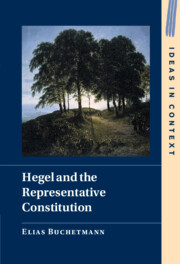Refine search
Actions for selected content:
63 results
The Power of Policy: Market-oriented Environmental Regulation and Green Transformation of Firms
-
- Journal:
- Management and Organization Review , First View
- Published online by Cambridge University Press:
- 27 August 2025, pp. 1-31
-
- Article
- Export citation
The impact of the Solicitors Qualifying Examination (SQE) on undergraduate legal education in England and Wales: A content analysis
-
- Journal:
- Legal Studies , FirstView
- Published online by Cambridge University Press:
- 31 July 2025, pp. 1-19
-
- Article
-
- You have access
- Open access
- HTML
- Export citation
University Education Reform and Entrepreneurship
-
- Journal:
- Management and Organization Review , First View
- Published online by Cambridge University Press:
- 29 July 2025, pp. 1-31
-
- Article
- Export citation
Change, Governance, and Diffusion of Institutional Logics in and Beyond Chinese Contexts
-
- Journal:
- Management and Organization Review / Volume 21 / Issue 3 / June 2025
- Published online by Cambridge University Press:
- 29 July 2025, pp. 417-442
-
- Article
-
- You have access
- Open access
- HTML
- Export citation
Environmentally Responsible or Irresponsible: Political Connections and Organizational Visibility
-
- Journal:
- Management and Organization Review / Volume 21 / Issue 3 / June 2025
- Published online by Cambridge University Press:
- 24 July 2025, pp. 538-561
-
- Article
- Export citation
Regulated markets and rationalised myths: an institutional perspective on value-based purchasing in the Netherlands
-
- Journal:
- Health Economics, Policy and Law , First View
- Published online by Cambridge University Press:
- 05 June 2025, pp. 1-16
-
- Article
-
- You have access
- Open access
- HTML
- Export citation
Institutional Origin and Chinese Family Firms’ Dot Tax Haven Internationalization
-
- Journal:
- Management and Organization Review / Volume 21 / Issue 2 / April 2025
- Published online by Cambridge University Press:
- 02 April 2025, pp. 225-249
-
- Article
-
- You have access
- Open access
- HTML
- Export citation
Problem indicators and territorial restructuring: do institutional decision rules matter?
-
- Journal:
- Journal of Public Policy / Volume 45 / Issue 1 / March 2025
- Published online by Cambridge University Press:
- 14 February 2025, pp. 45-67
-
- Article
-
- You have access
- Open access
- HTML
- Export citation
Chapter 17 - An Institutional Perspective on Strategy as Practice
- from Part III - Theoretical Resources: Organization and Management Theories
-
-
- Book:
- Cambridge Handbook of Strategy as Practice
- Published online:
- 11 March 2025
- Print publication:
- 23 January 2025, pp 313-331
-
- Chapter
- Export citation

Strategizing With Institutional Theory
-
- Published online:
- 21 May 2024
- Print publication:
- 13 June 2024
-
- Element
- Export citation
Religious Institutional Environment and Executive Pay Dispersion
-
- Journal:
- Management and Organization Review / Volume 20 / Issue 2 / April 2024
- Published online by Cambridge University Press:
- 03 May 2024, pp. 265-295
-
- Article
- Export citation
2 - Assessing the Response to the Climate Grand Challenge
-
- Book:
- Regenerative Strategies
- Published online:
- 28 March 2024
- Print publication:
- 04 April 2024, pp 10-42
-
- Chapter
- Export citation
19 - Nonprofits as Distributors of Toll Goods
- from Part III - New Directions
-
-
- Book:
- Reimagining Nonprofits
- Published online:
- 11 January 2024
- Print publication:
- 01 February 2024, pp 372-393
-
- Chapter
- Export citation
Expanding the Scope of Institutional Logics Research
-
- Journal:
- Management and Organization Review / Volume 19 / Issue 6 / December 2023
- Published online by Cambridge University Press:
- 05 January 2024, pp. 1185-1188
-
- Article
-
- You have access
- Open access
- HTML
- Export citation
8 - Managing across Borders
- from Part III - International Organisation
-
- Book:
- International Economics and Business
- Published online:
- 21 December 2023
- Print publication:
- 21 December 2023, pp 218-238
-
- Chapter
- Export citation
The impact of disaggregated formal institutional distance variables on entry mode decision: Evidence from Japan
-
- Journal:
- Journal of Management & Organization / Volume 31 / Issue 4 / July 2025
- Published online by Cambridge University Press:
- 31 August 2023, pp. 1768-1791
-
- Article
- Export citation
9 - Professional Advisory Services and CSR Responsibilisation, Accountability and Transparency
- from Part III - Stimulating Private Regulation of Corporate Social Responsibility
-
-
- Book:
- Corporate Social Responsibility Across the Globe
- Published online:
- 15 June 2023
- Print publication:
- 01 June 2023, pp 197-227
-
- Chapter
- Export citation
2 - The Values System Paradigm As a Regulatory Alternative to Stakeholder Needs CSR
- from Part I - Regulation Concepts, Paradigms and Approaches for Corporate Social Responsibility
-
-
- Book:
- Corporate Social Responsibility Across the Globe
- Published online:
- 15 June 2023
- Print publication:
- 01 June 2023, pp 11-38
-
- Chapter
- Export citation
What explains the spread of corporate social responsibility? The role of competitive pressure and institutional isomorphism in the diffusion of voluntary adoption
-
- Journal:
- Journal of Management & Organization / Volume 30 / Issue 3 / May 2024
- Published online by Cambridge University Press:
- 24 April 2023, pp. 765-786
-
- Article
- Export citation

Hegel and the Representative Constitution
-
- Published online:
- 13 April 2023
- Print publication:
- 20 April 2023
